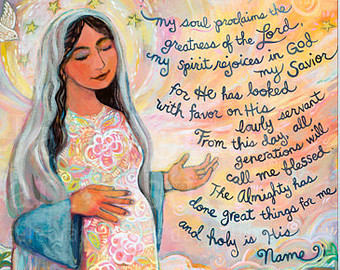
I can only imagine how horrifying it would be to outlive your son or daughter. It is not supposed to be that way. It is not nature’s way. Amped up to another level is that this grown child of yours is innocent, yet has been sentenced to death and there is nothing you can do.
That was the predicament of Mary when she saw Jesus die in a mangled mess on the cross. His passion was her passion. What comes in the next scene is a point of reference in Christianity on her unique maternal role and how her faith should be normative for Christians in example and practice. Knowing every breath is a struggle, the inner conflict of this mother is wanting to hear from him but to lift himself up must be excruciating.
Nevertheless, Jesus lifts himself up and speaks to put both his earthly and spiritual houses in order. An important legal backdrop according to Brant Pitre’s The Jewish Roots of Mary is that declarations of something being bestowed by the condemned at the site of their execution is legally binding. In Roman law, the witnesses of such words from Jesus could establish in court a last will and testimony. With a spiritual context and a secular frame of reference, he puts in place a familial connection to found his spiritual family: The Church. Therefore, a fruit of the cross is adoption through his mother Mary who always points us to Jesus Christ.
THE THIRD WORD
“Jesus said to his mother: “Woman, this is your son.”
Then he said to the disciple: “This is your mother.” (John 19:26-27)
Before these verses are explored, I want to lay some foundations. One is to acknowledge that in Mary there is a lot to learn from her faith. Second, no Christian could love Mary more than Jesus does. Third, in light of Jewish and early Christian tradition, she was the mother of Jesus alone in the manner of the flesh. Otherwise it would be strange for Jesus to bypass having another son of Mary take her in. The beauty is that she would have a spiritual and yet tangible role as mother eternally bonded in the cross to all Christians as I will demonstrate.
Decades before the cross, this “woman” was one who said yes to God’s will knowing there could be the appearance of scandal in pregnancy before the wedding ceremony. She said yes in a context of worship in saying, “my spirit rejoices in God my Savior” and “my soul magnifies the Lord”. But I want to especially emphasize that she was a woman of faith who rightly worshiped God and viewed humanity in a prophetic way.
She carried a devotion to her son that was not lost in statements she made about justice coming to mankind through Jesus. In her response to God in the presence of his angel she spoke of the high being made low and the poor being exalted. Such is what goes topsy-turvy when the full gospel impacts a culture: oneness and equality happen. This is something she celebrated when she first conceived Jesus in her heart before conceiving in her womb. This was Mary’s family morals for humanity because this was the agenda of God the Father in sending the Son.
But, Mary, was “full of grace” (Luke 1:28) and had discernment and a prophetic voice for Jesus in words and presence that endured to the day of Pentecost. Her life was lived in gratitude, treasuring the events of Jesus in her heart though anticipating the cross since old Simeon prophesied that a “sword will pierce your heart as well” (Luke 2:35).
She was also prophetic at a wedding as she magnified the Lord again though not with all clarity. She boldly interceded to Jesus for the need of more wine. Jesus did not dismiss her with the word “woman”, any more than he did from the cross. In fact, the idiomatic expression “what have you to do with me” is poorly translated in English and would seem he dismisses her. But Jesus was really communicating to her there is no barrier between them, his hour of the cross had not yet come yet borrowed time would start with that first miracle. She knew there would be a dark hour to come but Jesus knew that that hour was not that wedding but later. This would explain him saying this prior doing as she requested though he had said, “My hour has not come” (John 2:4).
She may have perceived a foreshadowing of the cross where she would be a witness to the wine of his blood poured out of his side, with water, to birth the reality of the Bride of Christ into sacramental existence. This is where her heart was pierced and how we see in Mary’s solidarity with Christ how his passion is felt by her and is relatable.
From the early years of Christianity, she has been written about as mother of all believers. She was and is the living reference of Christ’s nativity (the Christmas story) and the household of faith. This was strongly attested to by Origen of the 3rdCentury on how all Christians share in John’s blessing.
For none of these plainly declared His Godhead, as John does when he makes Him say, I am the light of the world, I am the way and the truth and the life, I am the resurrection, I am the door, I am the good shepherd; and in the Apocalypse [book of Revelation], I am the Alpha and the Omega, the beginning and the end, the first and the last. We may therefore make bold to say that the Gospels are the first fruits of all the Scriptures, but that of the Gospels that of John is the first fruits. No one can apprehend the meaning of it except he has lain on Jesus’ breast and received from Jesus Mary to be his mother also. Such as one must he become who is to be another John, and to have shown to him, like John, by Jesus Himself Jesus as He is. For if Mary, as those declare who with sound mind extol her, had no other son but Jesus.Is it not the case that every one who is perfect lives himself no longer, (Galatians 2:20) but Christ lives in him; and if Christ lives in him, then it is said of him to Mary, Behold your son Christ. What a mind, then, must we have to enable us to interpret in a worthy manner this work, though it be committed to the earthly treasure-house of common speech, of writing which any passer-by can read, and which can be heard when read aloud by anyone who lends to it his bodily ears? What shall we say of this work? He who is accurately to apprehend what it contains should be able to say with truth, “We have the mind of Christ, that we may know those thingswhich are bestowed on us by God” (Origen, Commentary of the Gospel of John, Book I, 3rdCentury. Quoted in personal conversation by Fr. John Behr, February 2019, emphasis added).
A proper response to feminist critiques of Christianity is to point to Mary as an example on the Christian dignity of women far beyond pregnancy. Before the conception of Jesus, she said, “let it be done unto me according to your word” (Luke 1:38). Mary’s grace informed femininity points to Christ. “Let it be done to me….” is an anthem for men and women to live a faith in harmony with God.
Good Mariology is good Christology in articulating Christ’s identity better. In Mary there is a fuller view of how “the Word became flesh and dwelt among us” (John 1:14). Mary is a controversial point in Protestantism, but the early Church put her in her elevated place to define all that Jesus is and be an example of all that the Church is called to be. This is why she was referred to as the Theotokos (God-bearer) in the Council of Ephesus in 431 AD. She was named the Theotokos in the Council of Ephesus not to glorify her but protect the doctrine of Jesus being 100% divine and 100% human. Mary refines the unity of faith and “magnifies the Lord”.
So, with that, let us now reflect on the full meaning of adoption in Christ being bound in spirit, matter and form but to God the Father. Let us take her into our home and invite her intercession, receive her exhortation to “do what he tells you” (John 2:5) and learn from her humility. In doing this we can be very much like John. Furthermore, she will behold us as her children and in Christ, “pray for us sinners now and in the hour of our death” (The Rosary) with a lifetime of life in the Church called to pray, teach and live the “Our Father”. Apostle Paul summed this up well on the adoptive effects of the gospel when he said, “For you did not receive a spirit of slavery to fall back into fear, but you have received a spirit of adoption. When we cry, ‘Abba!Father’ “(Romans 8:15)!
 I think about “Rocky Mountain High” when I think of retreat.
I think about “Rocky Mountain High” when I think of retreat.
